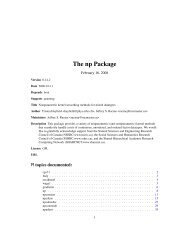The rgl Package - NexTag Supports Open Source Initiatives
The rgl Package - NexTag Supports Open Source Initiatives
The rgl Package - NexTag Supports Open Source Initiatives
You also want an ePaper? Increase the reach of your titles
YUMPU automatically turns print PDFs into web optimized ePapers that Google loves.
34 r3d<br />
r3d<br />
Generic 3D interface<br />
Description<br />
Details<br />
Generic 3D interface for 3D rendering and computational geometry.<br />
R3d is a design for an interface for 3d rendering and computation without dependency on a specific<br />
rendering implementation. R3d includes a collection of 3D objects and geometry algorithms. All<br />
r3d interface functions are named *3d. <strong>The</strong>y represent generic functions that delegate to implementation<br />
functions.<br />
<strong>The</strong> interface can be grouped into 8 categories: Scene Management, Primitive Shapes, High-level<br />
Shapes, Geometry Objects, Visualization, Interaction, Transformation, Subdivision.<br />
<strong>The</strong> rendering interface gives an abstraction to the underlying rendering model. It can be grouped<br />
into four categories:<br />
Scene Management: A 3D scene consists of shapes, lights and background environment.<br />
Primitive Shapes: Generic primitive 3D graphics shapes such as points, lines, triangles, quadrangles and texts.<br />
High-level Shapes: Generic high-level 3D graphics shapes such as spheres, sprites and terrain.<br />
Interaction: Generic interface to select points in 3D space using the pointer device.<br />
In this package we include an implementation of r3d using the underlying <strong>rgl</strong>.* functions.<br />
3D computation is supported through the use of object structures that live entirely in R.<br />
Geometry Objects: Geometry and mesh objects allow to define high-level geometry for computational purpose<br />
such as quadrangle meshes (qmesh3d).<br />
Transformation: Generic interface to transform 3d objects.<br />
Visualization: Generic rendering of 3d objects such as dotted, wired or shaded.<br />
Computation: Generic subdivision of 3d objects.<br />
At present, there are two main practical differences between the r3d functions and the <strong>rgl</strong>.*<br />
functions is that the r3d functions call open3d if there is no device open, and the <strong>rgl</strong>.* functions<br />
call <strong>rgl</strong>.open. By default open3d sets the initial orientation of the coordinate system in ’world<br />
coordinates’, i.e. a right-handed coordinate system in which the x-axis increasingfrom left to right,<br />
the y-axis increases with depth into the scene, and the z-axis increases from bottom to top of the<br />
screen. <strong>rgl</strong>.* functions, on the other hand, use a right-handed coordinate system similar to that<br />
used in <strong>Open</strong>GL. <strong>The</strong> x-axis matches that of r3d, but the y-axis increases from bottom to top, and<br />
the z-axis decreases with depth into the scene. Since the user can manipulate the scene, either<br />
system can be rotated into the other one.<br />
<strong>The</strong> r3d functions also preserve the <strong>rgl</strong>.material setting across calls (except for texture elements,<br />
in the current implementation), whereas the <strong>rgl</strong>.* functions leave it as set by the last<br />
call.<br />
<strong>The</strong> example code below illustrates the two coordinate systems.

















